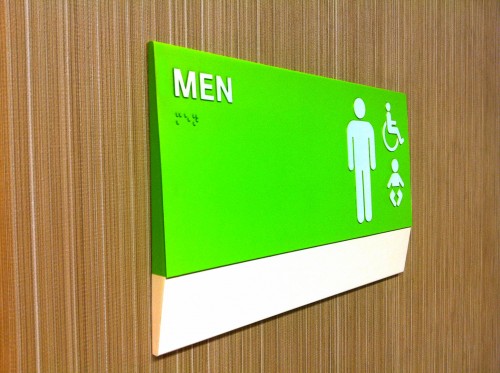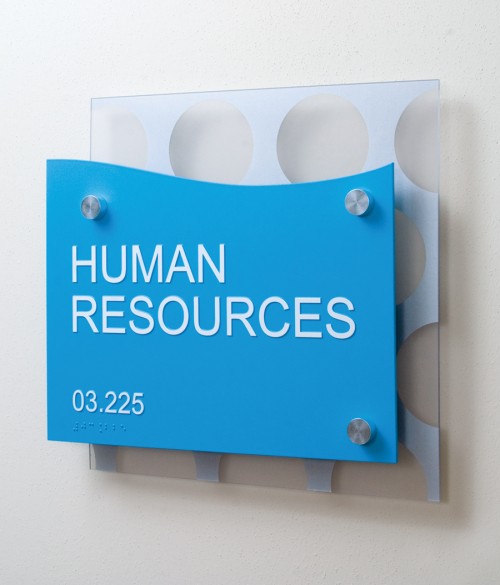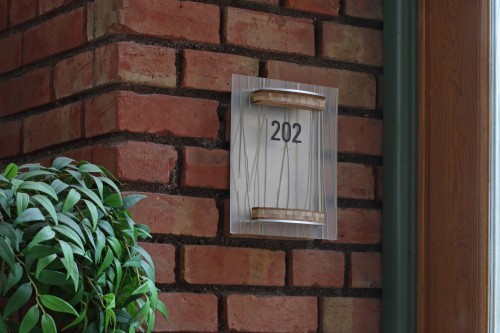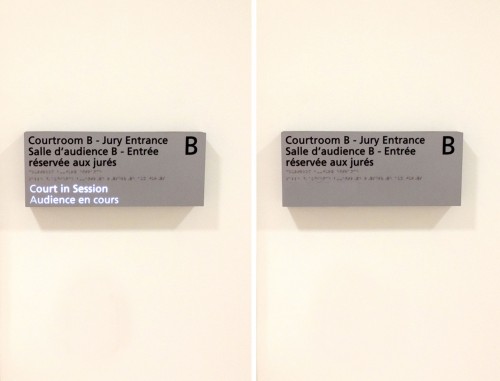Wayfinding: The benefits of photopolymer accessibility signage
by all | 20 June 2014 1:30 pm
 [1]
[1]Photos courtesy Acumen Visual Group
By Mike Santos
The use of braille dots on accessibility signage has gotten a lot of attention in recent years across the sign industry. Most accessibility signs identify a room or a space in a public facility where it is important to assist visitors in finding their way, including those with visual impairments.
In the U.S., all public facilities must comply with the 2010 Americans with Disabilities Act (ADA) Standards for Accessible Design (SAD). These standards include accessibility code requirements for braille on signs identifying all permanent rooms, along with other requirements governing colour contrast, mounting heights and other specifications.
In Canada, while there have been provincial efforts like the Accessibility for Ontarians with Disabilities Act (AODA), there is no enforceable national code for accessibility. This has not stopped overall progress, however, and many new facilities across Canada are being built with accessibility signage for room identification and wayfinding.
With a growing focus on accessibility has come innovation in sign materials. All facilities need signs anyway and making them accessible does not necessarily add much difficulty, but if the proper materials are used, they can enhance a facility’s overall design while ensuring a smooth navigational experience for all occupants.
Over the years, photopolymers—light-sensitive resins that harden when exposed to ultraviolet (UV) light—have emerged as the new industry standard in this respect. The unexposed sections of the resin dissolve in water during a washout process, leaving behind the raised elements, such as text and braille.
For today’s photopolymer signs, graphics are first created in a digital format, then a film negative is generated before the material is processed with UV light and water. Once the material has been processed, signs can be fabricated and decorated with the same conventional methods used for other typical substrates, including cutting, routing and painting.
 [2]
[2]Photopolymer resins enable control of the relief depth of raised elements, including text, braille dots and pictograms.
A photo finish
ADA, especially, was a major initiative to improve the lives of people with disabilities. The sign business was one of many industries affected by the new laws. For the first time, all public facilities across the U.S. needed to include braille text and tactile copy and graphics on their permanent room signs.
Photopolymer substrates were introduced to sign shops shortly after the original passing of ADA in 1991. They quickly gained favour for use in accessibility signs around the world.
Prior to 1991, photopolymers were used to produce high-quality graphics in flexographic and letterpress printing. The same photopolymer plates used for letterpress printing turned out to be ideal sign substrates, as many of them had a very hard durometer, were processed in plain tap water and were exposed to UV light for processing. As the photopolymer resin was extruded to the surface of a base substrate, it allowed control of the relief depth of raised elements, including text, braille dots and pictograms. With a few simple modifications to the resins, a new process was born for the sign industry.
The conversion of letterpress plates into accessibility signage substrates proved an overnight success, enabling sign fabricators to efficiently produce the high-quality pieces required to comply with ADA and similar regulations around the world, keeping up with rising demand.
In the earliest days of ADA, the photopolymer substrates had a thin aluminum backing, so the signs needed to be surface-painted. While they could feature tactile images, borders and logos, there was no way yet to incorporate any digitally printed graphics or simulate the appearance of other materials used in the same facility.
By the mid-1990s, photopolymers became available on a thicker phenolic backing. This did not enable more design options per se, but it did eliminate the need for additional mounting material to achieve the desired sign thickness, so it quickly became an industry-standard material.
In 1999, new clear photopolymer resins were mounted onto polyethylene terephthalate glycol (PETG) substrates and offered in a variety of base thicknesses. These materials spawned a new generation of accessibility signage. For the first time, fabricators could use a broad variety of design techniques and incorporate digitally printed graphics with braille dots and other raised elements on their accessibility signs.
 [3]
[3]Once photopolymers have been processed, signs can be fabricated and decorated with the same conventional methods used for other typical substrates, including cutting, routing and painting. Photos courtesy Nova Polymers
Accessibility meets creativity
Accessibility signs are an integral part of a building’s interior décor. So, as interior design has evolved, signs have changed to match. While their core function is wayfinding, they can also enhance a facility’s design.
Photopolymer substrates have evolved to meet these needs. Some of the clear versions allow for both first- and second-surface decoration. Some thinner-gauge varieties can be flexed to fit into curved-frame systems.
Most photopolymer substrates are intended only for indoor wayfinding sign systems, but a few are also designed for outdoor installation. It is important to specify a resin that will not swell in a moist environment, even if the finish coat is less than perfect. Otherwise, the sign could eventually collapse.
Design options include simulating natural and organic materials, solid colours, marble finishes and wood grain patterns, among others. Photopolymers can achieve this versatility by incorporating specialized laminates as their base substrates.
While photopolymers with a clear PETG base provide design advantages, as mentioned, there is still demand for substrates with an aluminum base. A brushed aluminum base can provide an attractive visual effect. Another option is a photoluminescent rigid polyvinyl chloride (PVC) base for safety and egress signs that need to remain visible in the dark.
Additional advantages
The first priority for any materials used in accessibility signs is to meet applicable code requirements. Secondly, they must meet the facility’s design needs. Photopolymer substrates have evolved for both of these purposes, but they also offer other benefits.
Sustainability
Beyond the development of accessibility sign codes, another trend that is influencing the choice of materials used in large facilities is the ‘green building’ movement. Signs can contribute in this respect, too. They can even help a building achieve a Leadership in Energy and Environmental Design (LEED) rating.
 [4]
[4]Many design options become possible by incorporating specialized laminates as base substrates.
Photopolymer signage involves an inherently very eco-friendly process. As mentioned, it uses plain tap water. It emits no volatile organic compounds (VOCs) and the effluent is 100 per cent biodegradable. A PETG base generally comprises at least 40 per cent post-industrial recycled content. By way of example, 3form’s ecoresin, a co-polyester recycled-content product, is Greenguard-certified by Underwriters Laboratories (UL). Any off-cuts can be recycled again.
Durability
With photopolymer-based signs, unlike some other options for accessibility signs, the braille dots and other tactile elements are integrally bonded with the substrate and base for a high level of durability. This occurs during the exposure process, when UV light cross-links the photopolymer molecules with the surface of the substrate, creating a bond that is stronger than the photopolymer itself.
Other manufacturing methods use a ‘sheet’ adhesive to attach a series of cut-out plastic components onto the substrate. While there are many ways of adhering these signs’ letters, dots and pictograms, they all essentially involve ‘taping’ them to the surface, which makes them very easy to vandalize.
Further, the photopolymer process requires a topcoat of paint or—for patterns and graphics—a clearcoat. This finish provides an additional layer of protection for the sign, enhancing its durability in the field.
Raised elements
As the photopolymer substrate is processed using UV light and a film negative, the sections exposed to the light harden and become the raised elements of the sign. In one simple step, it is possible to raise not just text and braille dots, but also borders, logos, pictograms, accent bars and other features.
The exposure process allows for these tactile elements to be very fine in detail, including those that would generally be too small or intricate to cut with a laser or computer numerical control (CNC) router.
High-volume production
The process of producing photopolymer signs involves several steps that are compatible with a high-volume workflow. Indeed, one photopolymer processing unit can effectively make more than 400 signs in a single shift.
The more intricate a sign becomes and the larger the number of pieces that are needed for a given job, the more profitable it becomes to use the photopolymer process rather than another method, in part because the material is processed in cycles that can be repeated all day, every day.
 [5]
[5]A sign at the Forensic Service and Coroner’s Complex (FSCC) in Toronto uses LEDs to indicate when court is in session. Photo courtesy Acumen Visual Group
Real-world examples
As the demand for accessibility signage has grown in the Canadian market despite the lack of ADA, some sign fabricators have begun to specialize in the use of photopolymer-based substrates. One example is Acumen Visual Group in Markham, Ont., which has worked with organizations, institutions, designers, architects and clients to develop unique accessibility sign systems.
In 2011, Acumen completed a wayfinding project for a downtown Toronto YMCA facility. Branded accessibility signage, fabricated using NovAcryl photopolymers, became a touchpoint for visitors, reinforcing the charitable organization’s spirit of inclusion. The specified photopolymers allowed Acumen to create custom tactile symbols and carry the building’s interior colour scheme across the signs.
Two years later, Acumen finished projects for Ontario’s new Forensic Service and Coroner’s Complex (FSCC) and St. Michael’s Hospital, both in Toronto.
For the FSCC, a public-private partnership (P3) project, Acumen worked with Carillion—a construction and facility management firm—and Webb Zerafa Menkes Housden Partnership (WZMH) Architects to develop both exterior and interior wayfinding signs, including an illuminated ‘court in session’ sign. This sign was made using a clear NovAcryl photopolymer with braille and tactile elements on one surface and the words ‘in session’ paintmasked on the second surface.
Light-emitting diodes (LEDs) were mounted inside the signbox, such that the flip of a switch on the back of the sign allows it to indicate when court is in session by illuminating the paintmasked letters.
Meanwhile, for St. Michael’s Hospital’s newly renamed Donnelly Wing and recently built Li Ka Shing Knowledge Institute, Acumen also handled not only exterior and interior wayfinding signs, but also donor recognition signage and a large-format exterior scrim. Partnering with Hahn Smith Design, the company was able to integrate sign colours as part of a larger overall wayfinding system, including floor graphics, directories, room identification, objects and the built environment, all designed to actively aid in the patient and visitor experience. All of the braille and tactile signs were made with photopolymers and decorated to match the other signs and interior elements.
“Since accessible signage is engaged in both visual and tactile ways, it facilitates a reciprocal relationship,” says Keith Francis, Acumen’s vice-president (VP) of strategic planning and business development. “It is both functionally informative and emotionally significant. There is a greater responsibility to design and fabricate products that serve to bridge the gap.”
Mike Santos is director of sales and marketing for Nova Polymers, which supplies raw materials and equipment for fabricating photopolymer signs. For more information, contact him via e-mail at msantos@novapolymers.com[6].
- [Image]: http://www.signmedia.ca/wp-content/uploads/2014/05/SMH-1.jpg
- [Image]: http://www.signmedia.ca/wp-content/uploads/2014/05/Colchester-.jpg
- [Image]: http://www.signmedia.ca/wp-content/uploads/2014/05/Terra_001_Interior_V-copy.jpg
- [Image]: http://www.signmedia.ca/wp-content/uploads/2014/05/IMG_2601.jpg
- [Image]: http://www.signmedia.ca/wp-content/uploads/2014/05/FSCC-1.jpg
- msantos@novapolymers.com: mailto:%20msantos@novapolymers.com
Source URL: https://www.signmedia.ca/wayfinding-the-benefits-of-photopolymer-accessibility-signage/